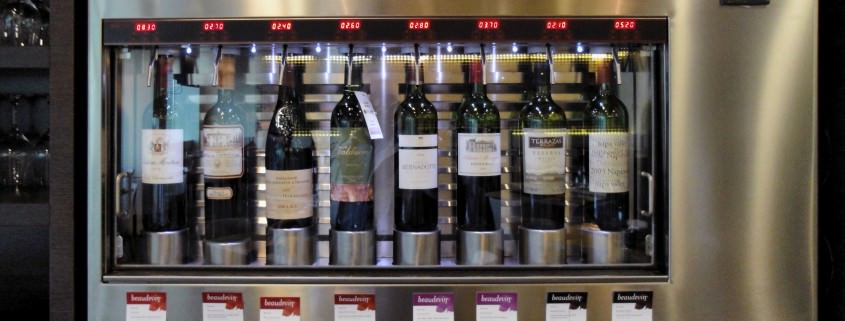Wine Dispensers (And Other Wine Preservation Dilemmas)
There’s a joke that generally goes something like this: “Someone told me I could make ice cubes from leftover wine. I’m confused…what’s leftover wine?” Of course, if you’re a bar or restaurant owner, you may not be laughing, as you know that having just the right amount and variety of wine for your clientele can be pretty tricky. You don’t want to run out of what patrons want, but you also don’t want to be stuck with inventory that’s not moving fast enough – especially once the bottle has been opened. You could steer away from offering wines by the glass, but will you alienate patrons who aren’t willing to order a whole bottle? As discussed previously here, a partial solution can be to offer specific pairings or wine flights to help move your inventory according to your needs.
Man vs. Machine
Speaking of wine flights, one restaurant that specializes in them, 3Twenty Wine Lounge in Los Angeles, employs another possible strategy for coping with the dilemma of how to keep wine (and potential profits) from going to waste: the wine-dispensing machine. 3Twenty allows customers to fill glasses themselves – from a lineup of Enomatic machines dispensing 2-ounce pours. Lounge staff mingle among them to answer questions and discuss the different varieties. Of course, there are those “wine snobs” who might argue that encouraging sophisticated, impromptu wine discussions this way thankfully draws attention away from the alleged tackiness of using wine dispensers to begin with. (Sure, the machines may keep wine fresh – and serve exactly the right amount every single time – but they’re… machines). As a side note, in some cases just quietly retrieving a glass of house wine from a box (which keeps a wine fresh weeks after it’s opened) may not be the worst crime in the world – but that’s not going to help you where most wine varieties are concerned.
Some have also questioned whether wine dispensing machines are only as trustworthy as their weakest link: those charged with operating, cleaning, and maintaining them; one wrong move, and the $10,000 to over $100,000 (plus maintenance costs) that you’ve invested in the equipment is all for naught. If that’s true, then perhaps we’re only left with the basic rules of proper wine handling and storage to preserve it the best we can: Keep bottles on their sides so that the liquid maintains contact with the cork, and store them in a cool place away from light – especially sunlight. Preferably the temperature should be no cooler than 45 degrees and no warmer than 65. The climate should be neither too dry nor too damp, instead falling between 50% and 80% humidity. Is that all we can do?
The Nuclear Option
Keeping an open bottle of Sauvignon Blanc, Chardonnay, Pinot Grigio, etc. cold may be a no-brainer, but what to do with the leftover red? The not-so-discussed, dirty little secret that’s been out since at least 1999 (when The New York Times wrote a whole article on the subject) is this: despite much controversy, many sommeliers are not at all opposed to discretely warming up cold red wine – by sticking it in the microwave for a maximum of 10 seconds. In fact, despite the fact that the ideal wine storage temperature was historically as low as 55 degrees, most contemporary American patrons find that temperature a bit on the icy side, so it’s not at all unheard of for your Malbec, Cabernet, Merlot, or Chianti to be warmed up a bit – by whatever means necessary, including putting a bottle in the dishwasher, running it under warm water, or wrapping it in a warm towel – before it’s served.
All in all, what it comes down to is that the War on Wine Waste can, realistically speaking, only be partly won – and that can usually only happen on a notable scale when and if it’s fought on a number of fronts. Which combat strategies are right for your establishment will depend on many factors, from your volume of business to your budget to the preference of the patrons who frequent your business. Either way, the better you strategize, the greater your chances of being able to actually laugh (and not cry) at the punchline: “Leftover wine? What’s that?”
- Uncorkd Adds New Vendor Purchasing, Tracking and Reporting Functionality - February 13, 2018
- Uncorkd Adds New Inventory Management Functionality with POS Integration - July 24, 2017
- How Many Red or White Wines Should You Have on Your List - May 3, 2016



